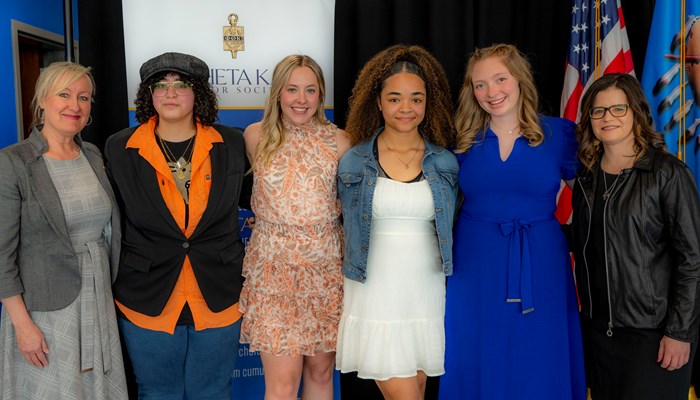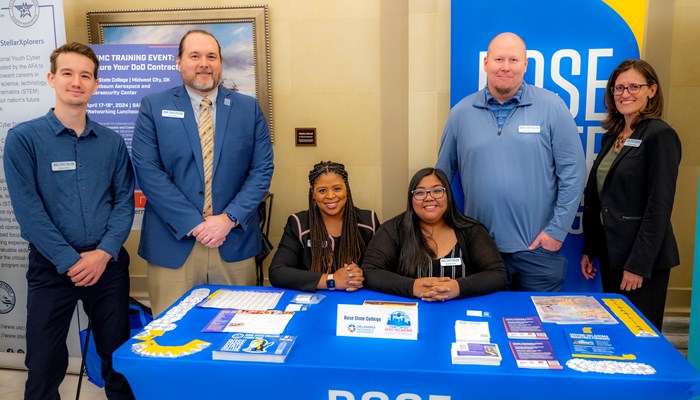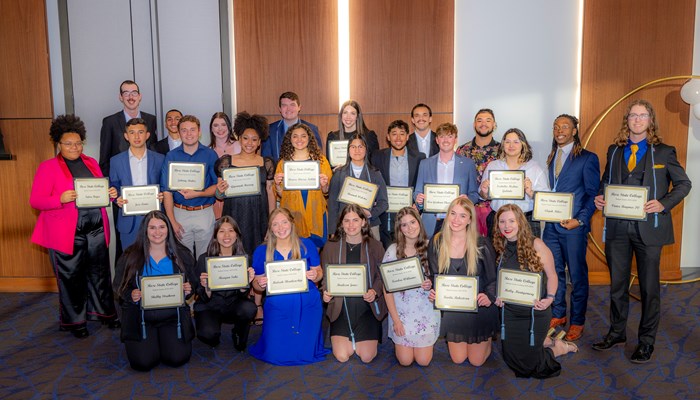Training the Next Generation of Drone Operators in Oklahoma Published January 16, 2018 by Daniel Beck
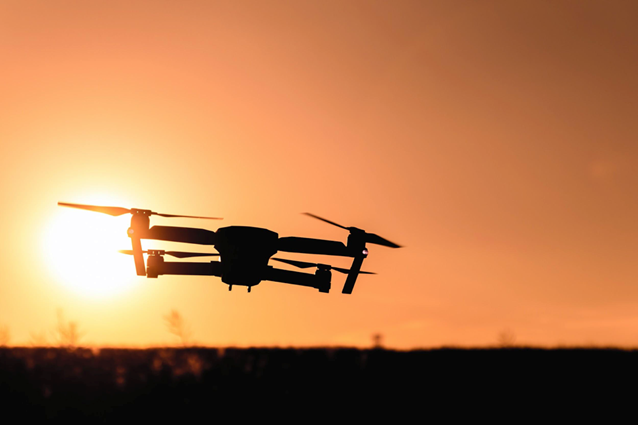
Unmanned Aircraft Systems (UASs), more commonly known as drones, are quickly breaking down barriers when it comes to technological advancement. Industries that have traditionally relied on manual labor are adopting drone technology to complete tasks more efficiently and reach areas previously inaccessible to man, while millions of consumers are buying up drones for personal use each year. In fact, drone sales among the consumer, enterprise, and government sectors are expected to surpass $12 billion by 2021.
With the growing potential for drone usage worldwide, preparing the next generation of drone operators and technicians is more important than ever. Rose State College and the University of Oklahoma (OU) have been given the opportunity to work together to transform students into leaders in the growing UAS industry in Oklahoma. Together, we are excited to provide our students with a strong competitive advantage and formal training, giving them experiential-based knowledge on the basics of drone technology and how these machines operate.
Bridging the Gap Between Midwest City and Norman
Representatives from Rose State College and OU saw an opportunity for Oklahoma to be positioned as a leader in UAS technology and wanted to find a way to provide students with the proper education to understand and operate drones. Considering the large oil, gas and engineering industries within the state, both institutions recognized the potential for a partnership to develop a curriculum surrounding drones. Key players from both schools met and discussed how they could work together to develop and educate students on UAS. The next step? Setting out to secure funds to make it possible.
Funding was acquired through a grant from the National Science Foundation’s Advanced Technology Education (ATE) program, which promotes improvement in the education of science and engineering technicians at the undergraduate level, with an emphasis on two-year colleges.
The ATE grant will provide Rose State College and OU funding for two years in which they will develop hands-on, technology-driven applications for teaching students about drones in an interactive way.
“We partnered with Rose State primarily because we thought Oklahoma could play a big role in the UAS industry and leading the education of future operators,” says Dr. Zahed Siddique, director and professor in the School of Aerospace and Mechanical Engineering at OU. “Especially because Tinker Air Force Base and other large aerospace companies are in the area--it just made sense. That’s how we started the conversation.”
Dividing the Funding
The financial dollars from this grant will go to professors and staff to help create the program, but also to students who will be assisting in the development and analysis of the curriculum.
For Rose State, the ATE grant meant being able to hire Dr. Jiyoon Lee as a professor in the Engineering and Science Division. Dr. Lee will oversee and develop drone curriculum and plans to integrate UAS principles into his existing curriculum. “I am going to connect UAS concepts to the existing course that I’m teaching and set up a project or problems for my students to work through revolving around UAS technology,” he says.
For OU, the majority of funding will go toward hiring student collaborators who will work alongside professors and staff to implement the project, develop experiential learning modules to be used in the classroom, collect data on how well students are learning the presented materials and offer training courses to receive the FAA 107 drone pilot license.
Having drone systems to observe and work with is also very important; therefore, funding also will go toward purchasing the drone equipment for students at Rose State to learn from. “Funding will also go toward equipment to build drones and UASs for educational purposes and obtaining instruments for performing experiments,” says Dr. Andrea L’Afflitto, OU assistant professor in the School of Aerospace and Mechanical Engineering.
Developing Drone-Centered Curriculum
Steven Fowler, professor in the Rose State Engineering and Science Division, shares that the goal of the program is to find ways to incorporate drone applications into existing courses at Rose State and to augment the concepts they’re already teaching. Rose State and OU will work closely to ensure that the curriculum and learning modules are effective and help students learn the necessary concepts.
“I’m looking forward to working with the four-year university and aligning our curriculum a little bit more than it currently is,” says Dr. Wayne Jones, dean of the Rose State Engineering and Science Division. “I think we do a good job of preparing our students to go onto the four-year institutions, but this will give us the chance to collaborate more and provide our students with a head start as they leave Rose State to pursue whatever is next for them.”
“The goal is for OU to build a research-driven drone program in which they can look at new applications or new ways to use drone technology,” says Fowler. “At Rose State, we hope to develop the front-end curriculum that will be used to show students how to use the existing drone technology and how it applies to the current engineering industry, as well as teach them the physics and calculus associated with developing drones.”
Dr. Siddique shares that throughout the three-year project, the two schools will work together to tailor the curriculum to what is effective teaching students as well as the evolving applications in the drone industry. “As Rose State is developing coursework, we’ll look at how interactive the curriculum is and look at some of the educational principles being applied,” he says. “At OU, we are also including drone concepts in some of our courses so that it becomes more of an integrated approach.”
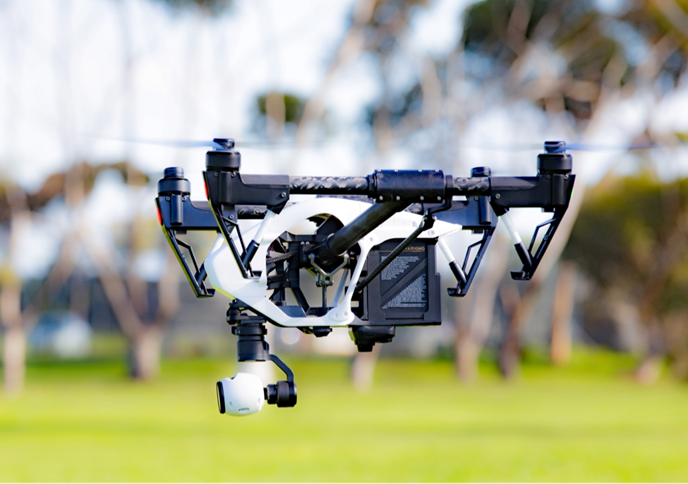
Goals for the Program
Having an interactive component is imperative for students to properly learn UAS technology. The goal isn’t necessarily to only teach students about how to use drones, but for it to complement the already existing coursework for engineering students.
Dr. Jones shares that they hope to develop two tracks for Rose State students, one through the technology program and another through the engineering program. “In the engineering program, we hope they’ll be prepared to go on to receive a bachelor’s degree with their new skills and be very successful and thrive, particularly at OU with our partnership there,” he says. “In the technology program, we have students that are looking to just get a two-year degree and work as technicians. We hope that they’ll leave with the skills to be able to do testing, maintenance, and have hands-on knowledge necessary for drone operation.”
“As part of this program, we also want students from Rose State to attend a course offered by the aviation program at OU that will allow them to become certified UAS pilots, according to FAA regulations,” Dr. L’Afflitto says. “This will allow them to easily prove their skills and competency in drone technology to future employers who are interested in hiring UAS operators.”
Dr. L’Afflitto also shares that students who understand the principles of how UASs work, can be modified, fixed, or redesigned are more qualified than engineering or technology students who are not explicitly trained for handling this unique kind of equipment.
“We want to educate students who would have a skillset in this unique field,” Dr. L’Afflitto says. “There are other universities and two-year colleges in the U.S. that are working on drone curriculum, but we’re definitely among the first ones that would be able to provide students this kind of skillset for the next generation of operators in the drone industry.”
The Need for UAS Education
Technology is continuing to change our perspectives and our way of doing things; it’s making us more efficient. Fowler reflects back to when GPS was a new technology and how important it has become for us today. He believes drones could have a similarly large impact in the future, even in the next 20 years.
“This new technology could really shape many things within our society and the hope is that we can arm our students, give them a base knowledge of what the physics and calculus looks like behind the drones,” Fowler says. “It’s not just this black box piece of equipment that you go buy. We want them to look at it and see what’s actually going on--the basics of drone technology.”
Dr. Lee adds that he hopes the drone program will provide motivation for students to not only understand drones, but to be able to form connections between the technology and how it can be applied to various industries. “There are so many fields, from small business up to larger companies, that are using UAS techniques,” he says. “Drones a hot item for the students, so we want to be able to teach them to connect them to real-world applications.”
As drone technology becomes more and more commercialized, there will be high demand for workers who understand and know how to operate them. “We want to prepare the next generation of students so that they will be ready when this technology becomes popular,” says Dr. L’Afflitto. “We have to do this very much ahead of time so that students from Oklahoma will be at the forefront when this technology becomes mainstream in five to 10 years.”
Which Industries Would Benefit from Drones?
The applications for drone technology are almost limitless when you consider the many industries that could benefit from unmanned aircrafts. In Oklahoma, for example, oil and gas refineries are already using drones to inspect parts of the refineries which are otherwise hard to access.
Dr. Lee shares that “we cannot limit the scope of the usage of the drone,” and envisions many different industries that could be using them. Fowler continues that “it’s almost unlimited where the applications can be used.”
“Application-wise, there are a million applications for drones and there is already a wide range of applications in which drones are being currently used,” Dr. Siddique adds. “Amazon and other companies are getting into using UASs for delivery and interacting with customers. There are great possibilities for agriculture--applications like this, which are relevant to not only Oklahoma, but the region and the U.S. as a whole.”
Below are some examples of the wide-ranging uses for drone technology in Oklahoma and how drones are currently being used.
Agriculture
For farmers, drones have proven to be very helpful in surveying farm lands and making sure everything is in order. “They can check their livestock numbers or even measure crops and the area of their fields without having to do it manually,” Dr. Lee says.
Those in the agriculture industry can even use drones to spot the signs of crop diseases before they spread and customize the way in which pesticides, water, and fertilizer are applied to fields--which in turn could lead to greater crop yields.
Forestry
There are countless opportunities for drones to make complicated tasks simpler. Fowler provides an example. “There’s a lot of work using drones to identify the number of trees within an area and mapping them out so that foresters can virtually walk through a forested area and count tree populations,” Fowler says. “By flying a drone over the area and taking a few pictures, you can stich those together with Google Earth-type technology (GIS technology), and create models.”
Oil and Gas
The oil and gas industry is already using drones to inspect gas lines. “Drones could be used to inspect gas lines more effectively--they can determine where leaks are or determine the condition of gas lines that might be in a remote location where you might not want a human to venture into,” Dr. Jones says. “They can also make projects less time consuming.”
Military
The U.S. military has been using drones in combat since 2001 and has been rapidly expanding its drone fleet ever since. Drones allow the military to monitor areas deemed “unsafe” for manned aircraft and can provide surveillance 24-hours a day.
Insurance
In Oklahoma specifically, drones could be used in the future to help insurance companies inspect hail damage on roofs or see the extent of damage done by tornadoes without having to send humans into dangerous areas.
Looking to the Future
Dr. L’Afflitto hopes the drone program developed by Rose State and OU will become a model for colleges across the nation. “What our model includes is a two-year college, a nearby four-year university, and some industry that’s interested in the use of drones,” he says. “If you think about it, these three elements exist in every state to some extent or another. We would like to publicize our model, our course structure, and some of the materials we will produce so that other universities and colleges will be able to mimic our model and we can bring our lessons learned outside of Oklahoma.”
“We’re excited to partner with Rose State,” says Dr. Siddique. “I think this will put Oklahoma in new light and we’ll have more capable, trained personnel coming out of this program with advanced technical knowledge that they can apply across a range of industries.”
Rose State looks forward to offering this program and drone-based curriculum to their students interested in UAS technology and engineering. Learn more from our Engineering and Science Division and get started at Rose today!
Any opinions, findings, and conclusions or recommendations expressed in this material are those of the author(s) and do not necessarily reflect the views of the National Science Foundation.
